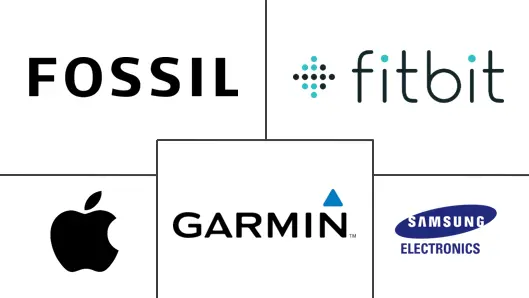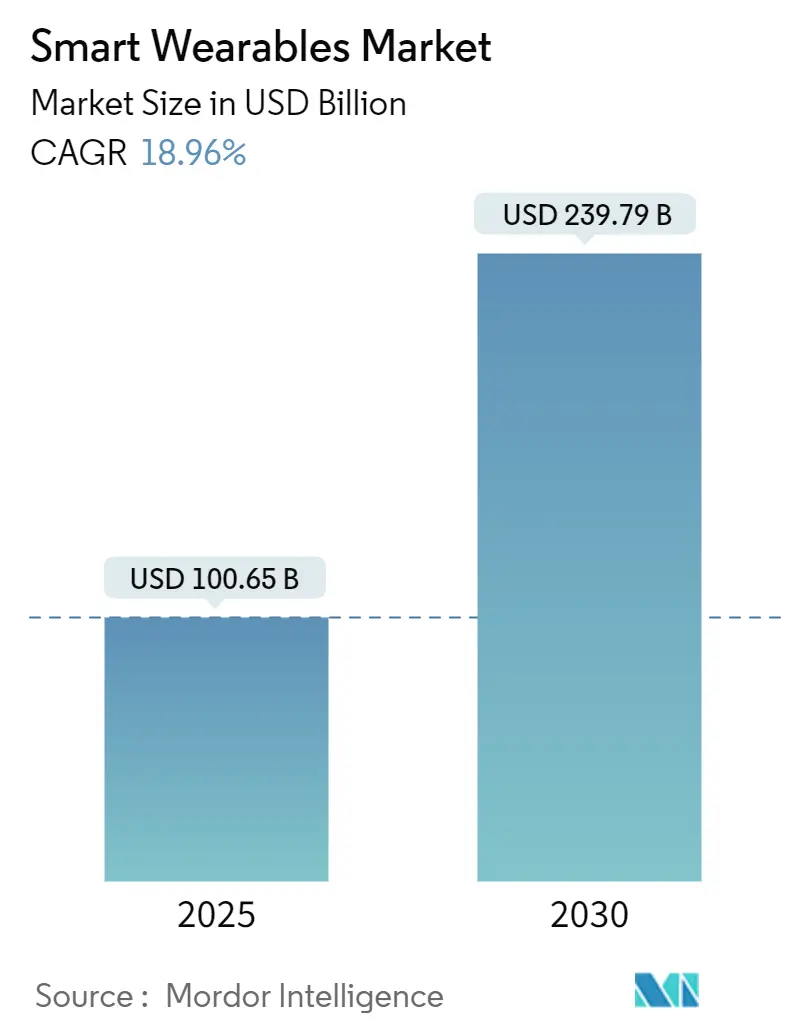
Smart Wearable Market Analysis by Mordor Intelligence
The smart wearable market size stands at USD 100.65 billion in 2025 and is forecast to reach USD 239.79 billion by 2030, advancing at an 18.96% CAGR. Accelerating sensor innovation, better on-device AI, and broader cellular coverage are expanding use cases from casual wellness to regulated healthcare. Growing insurer reimbursement for remote monitoring, rising enterprise safety mandates, and 5G Stand-Alone roll-outs are opening new addressable segments. Hardware remains dominant, yet recurring services revenue is reshaping vendor economics. Platform-centric strategies and cross-device ecosystems are becoming decisive for user retention and lifetime value across the smart wearable market.
Key Report Takeaways
- By product category, smartwatches led with 46.5% of smart wearable market share in 2024; smart rings and jewelry are projected to post the fastest CAGR at 19.8% through 2030.
- By component, hardware accounted for 74.1% revenue share in 2024, while services and subscriptions are projected to expand at a 20.4% CAGR between 2025–2030.
- By connectivity, Bluetooth/BLE held 55.7% share in 2024; 5G Stand-Alone is forecast to grow the fastest at 21.2% CAGR to 2030.
- By application, healthcare wearables represented the fastest-growing segment at a 22.6% CAGR, whereas consumer electronics retained 57.3% share of the smart wearable market size in 2024.
- By geography, Asia Pacific captured 34.9% of smart wearable market size in 2024; the Middle East and Africa region is set to record the highest regional CAGR at 20.7% from 2025–2030.
Global Smart Wearable Market Trends and Insights
Drivers Impact Analysis
| Driver | (~) % Impact on CAGR Forecast | Geographic Relevance | Impact Timeline |
|---|---|---|---|
| Insurance-approved cardiac RPM wearables | +3.2% | North America, spillover to Europe | Medium term (2-4 years) |
| Healthy China 2030 smartwatch subsidies | +2.8% | China, broader Asia Pacific | Medium term (2-4 years) |
| Enterprise hearables for hybrid-work safety | +2.1% | European Union, global corporates | Short term (≤2 years) |
| AI-on-chip non-invasive glucose monitoring | +3.5% | North America and Europe, global later | Medium term (2-4 years) |
| Defense exoskeleton procurement | +1.7% | North America, NATO allies | Long term (≥4 years) |
| Pay-as-you-lift industrial exoskeleton leasing | +1.4% | Southeast Asia, other emerging markets | Medium term (2-4 years) |
| Source: Mordor Intelligence | |||
Insurance-approved wearables for cardiac remote monitoring in North America
Rapid adoption of remote patient monitoring codes under the 2025 Physician Fee Schedule is motivating primary-care practices to prescribe ECG-class wearables. Monthly reimbursements of USD 15-110 per patient lower cost barriers for providers, and hospitals report 15% fewer readmissions for congestive heart failure.[1Medical Economics Editorial Team, “Remote Patient Monitoring in 2025: The Major Changes Physicians Need to Know About,” Medical Economics, medicaleconomics.com] Nearly one-third of US clinics have already embedded continuous monitoring into chronic-care workflows, reflecting a material shift from episodic to longitudinal data capture. Higher patient adherence stems from untethered form factors and real-time clinician feedback loops, reinforcing the growth outlook of the smart wearable market.
China’s dual-use smartwatch subsidies under Healthy China 2030
Government incentives that reimburse part of the retail price for devices certified to deliver both lifestyle and medical functions are stimulating local R&D and domestic demand. Brands such as Xiaomi and Huawei leveraged the program to scale unit shipments, accelerating time-to-market for SpO2-grade sensors and arrhythmia detection algorithms. The policy is also harmonizing consumer electronics and medical device standards, reducing regulatory friction for exports across the wider Asia-Pacific smart wearable market.
Enterprise-grade hearables shaped by EU hybrid-work norms
New European occupational-safety rules demand continuous environmental monitoring and hands-free communication in flexible workplaces. Companies are issuing multi-sensor hearables that blend noise cancellation, live translation, and biometrics to mitigate fatigue and cognitive overload. A majority of EU facilities managers budget for wearable roll-outs within 24 months, spurring volume growth in a previously consumer-centric product class.
Rise of AI-on-chip wearables enabling non-invasive glucose monitoring
Edge AI processors now execute optical and bio-impedance models locally, estimating glucose trends without lancets. Bluetooth LE chipsets designed for on-board inference are slated to exceed 1.8 billion units in annual shipments, enabling week-long battery life and enhanced data privacy.[2]Nordic Semiconductor Corporate Communications, “A Vision for Tomorrow’s Wireless World,” nordicsemi.com This advance broadens the total addressable pool to include pre-diabetics and general wellness users, propelling the medical segment of the smart wearable market.
Restraints Impact Analysis
| Restraint | (~) % Impact on CAGR Forecast | Geographic Relevance | Impact Timeline |
|---|---|---|---|
| Data-residency mandates for cloud companion apps | -1.8% | European Union, global spillover | Medium term (2-4 years) |
| Thermal-runaway risk in ultra-slim smartwatch batteries | -1.2% | Global, stricter in safety-focused regions | Short term (≤2 years) |
| Gesture-ring patent litigation costs | -0.9% | North America, Europe, expanding globally | Medium term (2-4 years) |
| Low ARPU slowing 5G SA wearables in LATAM | -1.1% | Latin America | Medium term (2-4 years) |
| Source: Mordor Intelligence | |||
Data-residency mandates limiting cloud companion apps in Europe
EU regulators now require health data to reside within regional borders, compelling vendors to build local processing stacks or risk feature downgrades.[3]Journal of Medical Internet Research Editorial Board, “Usage Trends and Data Sharing Practices of Healthcare Wearable Devices Among US Adults,” jmir.org Smaller players face higher compliance costs, while user willingness to share sensitive data remains low, curbing network-effect benefits. Fragmented architectures can lengthen update cycles and complicate multi-region releases, tempering the near-term expansion of the smart wearable market in Europe.
High-density battery thermal-runaway concerns in ultra-slim smartwatches
Pursuit of sub-10 mm chassis height pushes lithium-polymer cells to energy densities that narrow safety margins. New certification layers add design iterations and delay launch timelines. Premium vendors weigh the trade-off between aesthetic appeal and larger, safer casings, slowing refresh cycles and raising supply-chain costs.
Segment Analysis
By Product: Evolving beyond the wrist
Smartwatches retained clear leadership in 2024 with a 46.5% revenue share. Flagship models combine multi-band GPS, ECG, and medical-grade photoplethysmography while improving battery life through low-temperature poly-silicon OLED panels. Dual-sensor arrays support atrial-fibrillation alerts that comply with FDA Class II requirements, strengthening the clinical utility proposition across the smart wearable market.
Smart rings and jewelry record the fastest growth as miniaturized MCU packages and solid-state batteries support continuous SpO2 and heart-rate tracking in a 3-gram form factor. Premium variants target sleep optimization, whereas mass-market models emphasize discreet activity logging. Hearables broaden the category footprint by integrating temperature and cognitive-load sensors, creating an audio-first gateway into workplace safety programs. Fitness trackers move upscale into recovery analytics and VO₂-based training readiness, while head-mounted displays gain traction in surgical guidance and field maintenance. Early-generation smart textiles embed stretchable electrodes for posture correction and stress detection, hinting at future expansion of the smart wearable market into everyday apparel.
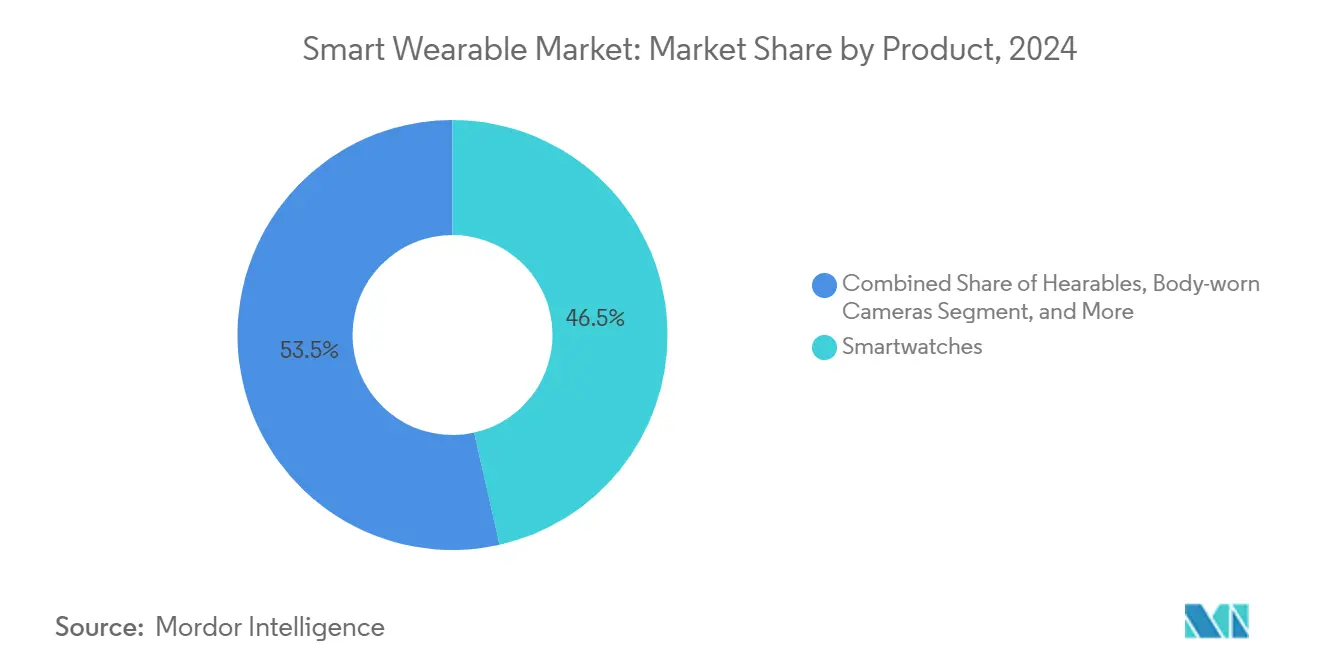
Note: Segment shares of all individual segments available upon report purchase
By Component: Hardware dominates, services scale faster
Core silicon, optical modules, and batteries accounted for 74.1% of 2024 revenue. Suppliers advance 6-nanometer chipsets with neural acceleration to enable on-device classification for arrhythmia and blood-oxygen anomalies. Flexible AMOLED panels and low-loss RF front ends improve efficiency, extending single-charge endurance to seven days on flagship watches.
Recurring services are growing on the back of premium analytics, personalized coaching, and EHR integration. Vendors bundle AI-based sleep improvement plans or nutrition guidance into monthly tiers, lifting average revenue per user and smoothing upgrade cycles. Software remains the glue layer, supporting over-the-air feature extensions that lengthen device lifetimes and fortify ecosystem lock-in in the smart wearable market.
By Connectivity: Ubiquitous Bluetooth, rising 5G
Bluetooth/BLE held 55.7% share in 2024 thanks to near-universal smartphone pairing and low-power transfers under 2 mA. Bluetooth LE Audio further reduces power draw while doubling throughput, opening lossless music and real-time language translation use cases.
5G Stand-Alone modules leverage RedCap to enable untethered high-bandwidth streaming and sub-20 ms latency for remote diagnostics. Advanced antenna-in-package designs shrink footprints to 100 mm², making cellular modems viable in rings and patches. LTE-M and NB-IoT remain relevant for elder safety pendants and asset tracking tags. NFC continues to underpin contactless payments, and UWB unlocks centimeter-level indoor positioning critical for workplace safety wearables.
By Application: Healthcare outpaces consumer lifestyle
Consumer lifestyle retained 57.3% of 2024 revenue as notifications, contactless pay, and music playback stay routine. Yet medical adoption is accelerating at 22.6% CAGR. Clinical trials show wearable heart-rate variability and motion data can predict inflammatory bowel disease flare-ups weeks in advance, expanding payer coverage.[4]Mount Sinai Newsroom, “Wearable Devices Can Detect IBD Flare-Ups,” mountsinai.org Sports performance platforms ingest multi-sensor data into AI coaches that prescribe micro-periodization schedules, keeping elite athlete adherence above 90%. Industrial safety programs bundle environmental gas monitors and posture sensors to cut accident rates and boost output, elevating enterprise demand within the smart wearable market.
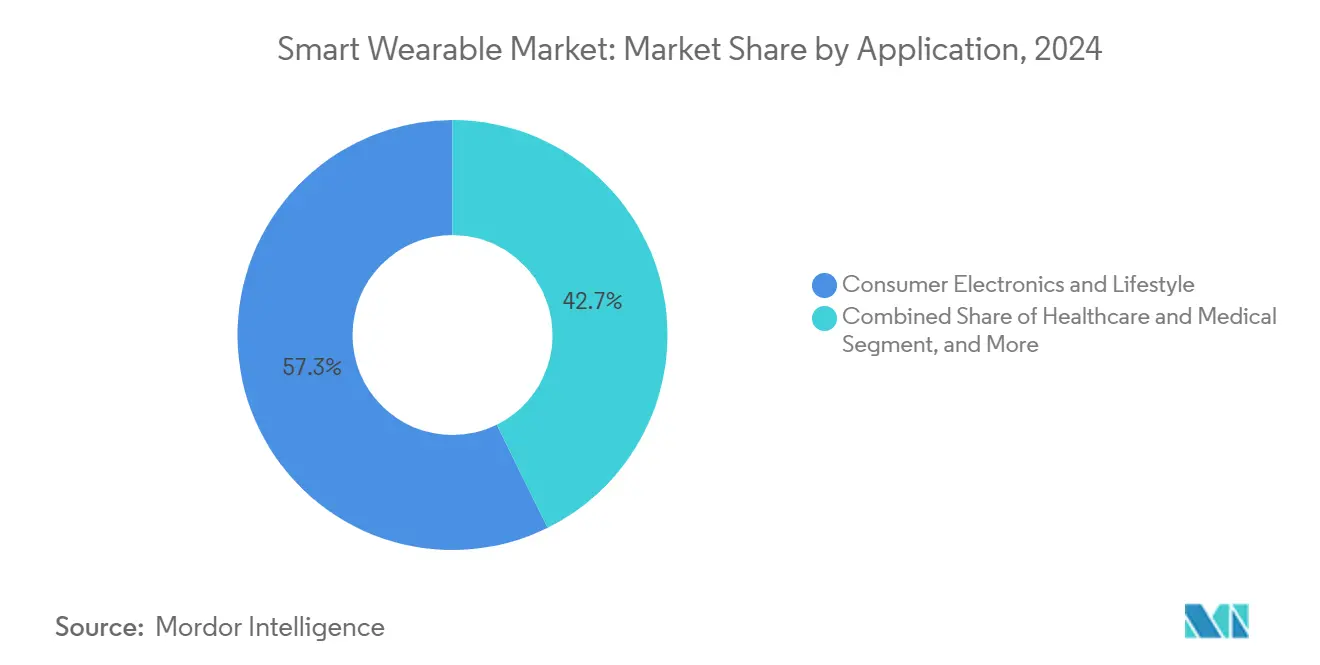
Note: Segment shares of all individual segments available upon report purchase
By Distribution Channel: Clinical pathways surge
Online stores commanded 62.4% of 2024 sales, benefiting from global reach and serialized firmware delivery. Providers increasingly prescribe devices that ship directly to patients, maintaining e-commerce relevance. Clinics and pharmacies, however, are growing fastest at 23.3% CAGR as insurers reimburse hardware bundled into care plans. Physical electronics retailers focus on immersive demo zones to showcase haptics and health dashboards, preserving their role for high-end devices.
Geography Analysis
Asia Pacific held 34.9% of 2024 revenue. Vertically integrated supply chains enable rapid cost declines and two-month model refreshes. Government programs subsidize ECG-enabled wearables, raising adoption among first-time buyers and chronic-disease patients.
North America remains the premium epicenter, underpinned by early medical credentialing and robust payer engagement. Reimbursement for remote patient monitoring widens device access, and institutional research validates predictive models, reinforcing trust in the smart wearable market.
Europe balances strong demand with strict data-sovereignty rules. Vendors deploy edge-only analytics and in-region data lakes to comply with GDPR, while corporate safety mandates accelerate hearables roll-outs.
The Middle East and Africa post the highest growth at 20.7% CAGR, catalyzed by 5G Advanced coverage and national e-health blueprints that leverage wearables to extend care to under-served communities. South America sees uneven uptake due to currency swings and 5G cost, but localization partnerships and wellness subsidies in Brazil and Mexico provide momentum.
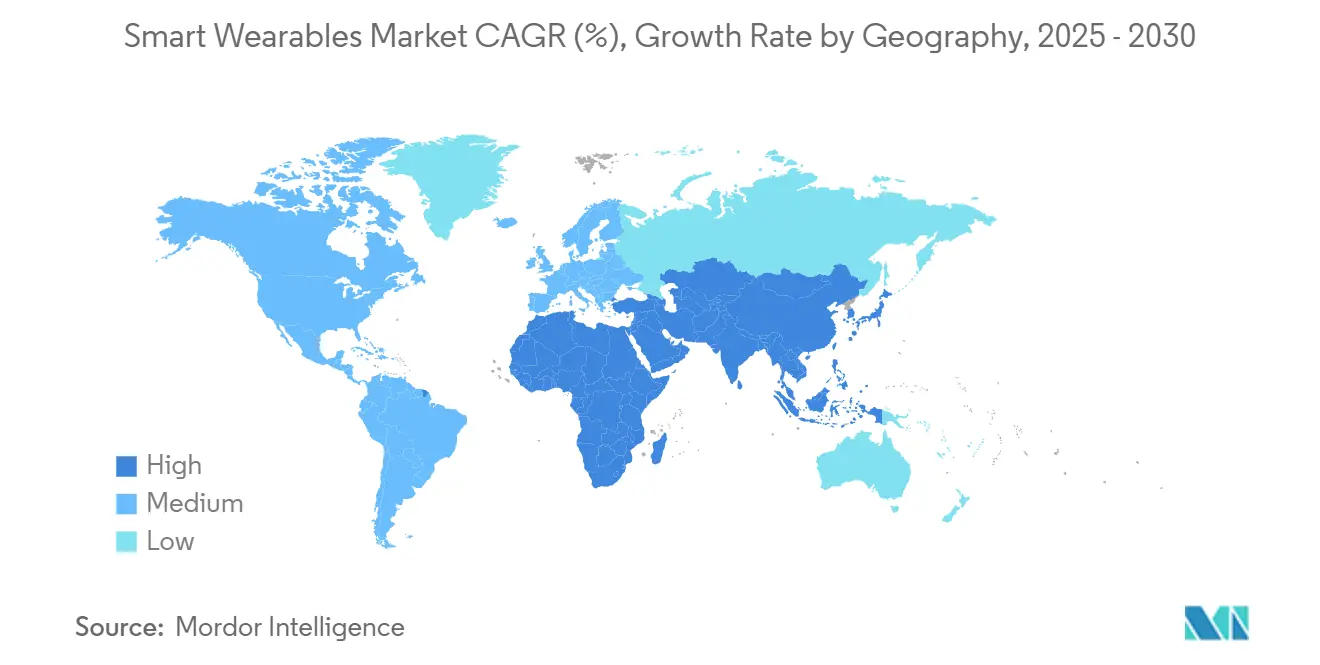
Competitive Landscape
Category leaders such as Apple, Samsung, and Huawei consolidate share through proprietary silicon, unified operating systems, and integrated cloud services. Xiaomi’s ecosystem approach drove 8.7 million band shipments in Q1 2025, displacing Apple in unit terms. Vertical integration secures component supply and enables differentiated power management that rivals find hard to replicate.
Niche innovators carve spaces in smart rings, medical patches, and industrial exoskeletons. Partnerships between component suppliers and robotics firms accelerate go-to-market. OLED material breakthroughs by Universal Display Corporation reduce panel power draw by 25%, extending battery life and reinforcing premium positioning. Growing patent litigation around gesture interfaces and biosensing IP signals intensifying rivalry as the smart wearable market matures.
Smart Wearable Industry Leaders
-
Apple Inc.
-
Fitbit Inc.
-
Fossil Group Inc.
-
Samsung Electronics Co., Ltd.
-
Garmin Ltd.
- *Disclaimer: Major Players sorted in no particular order
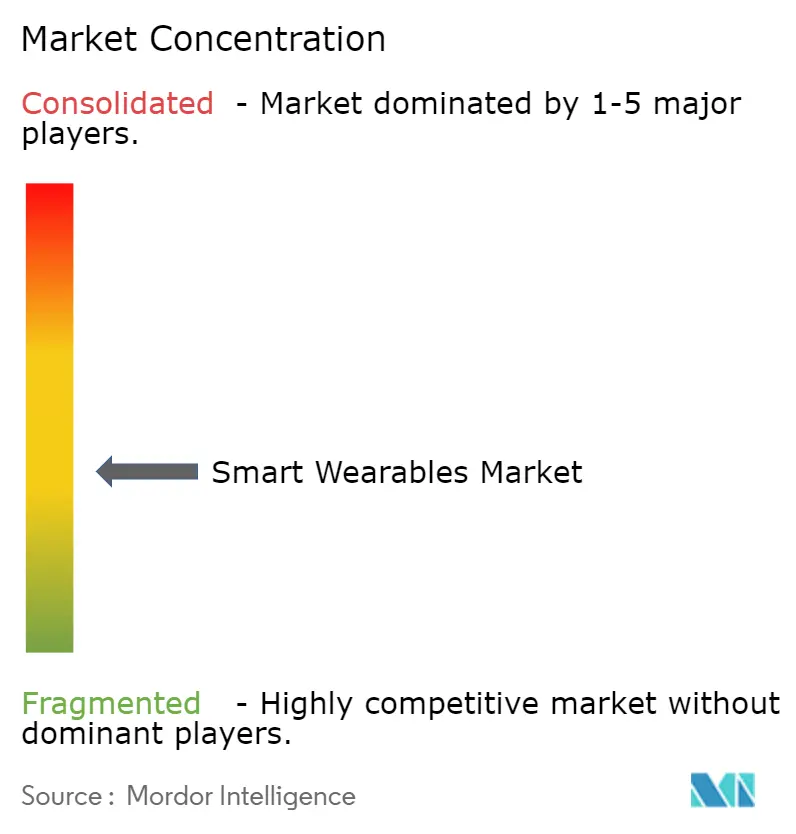
Recent Industry Developments
- May 2025: Retrieve Medical Holdings and MyID created a joint venture to ship the first wearable that streams provider-verified EHR data via national HIEs.
- May 2025: KULR Technology Group partnered with German Bionic to localize production of AI-powered Apogee ULTRA exoskeletons in the US.
- May 2025: Huawei launched Watch 5 with aerospace-grade materials and Multi-sensing X-TAP health suite at EUR 450.
- March 2025: Defense Health Agency canceled a USD 96 million biometric-ring contract after protests, highlighting procurement scrutiny in defense wearables.
- February 2025: Huawei unveiled the Mate XT tri-foldable alongside updated wearables, demonstrating ongoing innovation despite supply-chain constraints.
Research Methodology Framework and Report Scope
Market Definitions and Key Coverage
Our study defines the smart wearables market as revenues generated from connected, sensor-laden devices worn on the body, including smartwatches, hearables, head-mounted displays, smart clothing, rings, and medical-grade patches, sold to consumers and enterprises worldwide. According to Mordor Intelligence, values are expressed in constant 2024 US dollars and cover hardware, embedded software, and bundled companion apps.
Scope exclusions: Implantable medical devices and stand-alone fitness equipment are not counted.
Segmentation Overview
- By Product
- Smartwatches
- Hearables (Ear-Worn/Smart Earbuds)
- Fitness and Activity Trackers
- Head-Mounted Displays (AR/VR/MR)
- Smart Clothing and Textiles
- Body-worn Cameras
- Smart Rings and Jewelry
- Medical Wearable Patches and Biosensors
- Powered Exoskeletons
- By Component
- Hardware
- Software and Apps
- Services and Subscriptions
- By Connectivity Technology
- Bluetooth/BLE
- Cellular (3G/4G/LTE-M)
- 5G Stand-Alone
- NFC/RFID
- Wi-Fi/WLAN
- Others (UWB, ANT+)
- By Application/End-use
- Consumer Electronics and Lifestyle
- Healthcare and Medical
- Fitness and Sports
- Industrial and Enterprise Safety
- Military and Defense
- By Distribution Channel
- Online (Brand E-store, Marketplaces)
- Offline (Consumer Electronics Stores, Specialty, Clinics)
- By Geography
- North America
- United States
- Canada
- Mexico
- Europe
- Germany
- United Kingdom
- France
- Italy
- Spain
- Rest of Europe
- Asia-Pacific
- China
- Japan
- South Korea
- India
- South East Asia
- Rest of Asia-Pacific
- South America
- Brazil
- Rest of South America
- Middle East and Africa
- Middle East
- United Arab Emirates
- Saudi Arabia
- Rest of Middle East
- Africa
- South Africa
- Rest of Africa
- Middle East
- North America
Detailed Research Methodology and Data Validation
Primary Research
Mordor analysts interviewed component suppliers in Taiwan, contract manufacturers in Vietnam, digital health clinicians in the United States, and direct-to-consumer brand managers in Europe. The conversations clarified BOM cost trajectories, regulatory milestones, and emerging service-based revenue streams that secondary data alone could not capture.
Desk Research
We began by gathering shipment and trade data from sources such as UN Comtrade, the US International Trade Commission, Eurostat, and China Customs to size cross-border flows. Complementary insights were drawn from the World Bank's disposable-income indicators, IDC's quarterly wearable tracker, Bluetooth SIG adoption statistics, and peer-reviewed journals that quantify health monitoring use cases. Our team then accessed D&B Hoovers and Dow Jones Factiva to verify vendor financials and new-product launches that influence average selling prices.
These public and subscription materials provide the factual backbone of our model; however, they are illustrative, not exhaustive, and many additional publications, filings, and association briefs were consulted for confirmation.
Market-Sizing & Forecasting
Top-down reconstruction starts with national import-export matrices and retail sell-through audits, which are then aligned with global shipment totals. We cross-check these totals with bottom-up roll-ups of sampled vendor shipments multiplied by region-specific ASPs, filling data gaps through channel checks where disclosure is limited. Key variables in the model include smartwatch penetration within smartphone users, Bluetooth-only versus cellular mix, ASP erosion rates, disposable-income growth, and healthcare reimbursement programs for remote monitoring devices. A multivariate regression projects each driver to 2030, after which scenario analysis adjusts for currency and policy shocks.
Data Validation & Update Cycle
Models pass two levels of analyst review, variance thresholds trigger re-contact with sources, and refreshes occur annually, with interim updates after material events such as major chipset releases.
Why Mordor's Smart Wearables Baseline Commands Reliability
Published estimates often differ because firms choose dissimilar product baskets, price definitions, and refresh cadences.
We anchor our baseline around transaction-level trade evidence and verified ASP trends, giving decision-makers a reproducible starting point.
Benchmark comparison
| Market Size | Anonymized source | Primary gap driver |
|---|---|---|
| USD 100.65 B | Mordor Intelligence | - |
| USD 209.8 B | Global Consultancy A | Includes industrial exoskeletons and POS wearables, minimal ASP normalization |
| USD 150.28 B | Industry Think Tank B | Uses shipment counts multiplied by list prices, limited country-level validation |
Taken together, the comparison shows that Mordor's disciplined scope selection, dual-approach modeling, and yearly refresh cycle yield a balanced, transparent baseline that clients can trace back to clear variables and repeatable steps.
Key Questions Answered in the Report
What is the current value of the smart wearable market?
The smart wearable market size is USD 100.65 billion in 2025 and is on track to reach USD 239.79 billion by 2030.
Which product type dominates revenue today?
Smartwatches hold the largest slice at 46.5% of smart wearable market share for 2024, thanks to versatile health and communication feat
Why are services and subscriptions growing faster than hardware?
Recurring analytics, coaching, and EHR integrations provide ongoing value, driving a projected 20.4% CAGR for service revenue through 2030.
How is 5G affecting wearables?
5G Stand-Alone modules enable untethered high-bandwidth connections, supporting real-time medical telemetry and immersive media without smartphone dependence.
Which region shows the strongest growth outlook?
The Middle East and Africa is forecast to expand at 20.7% CAGR between 2025 and 2030, driven by 5G network roll-outs and rising healthcare digitization.
What are the main regulatory hurdles in Europe?
EU data-residency rules require health data to stay within regional borders, compelling vendors to build localized processing and storage solutions, which increases compliance cost and time-to-market.
Page last updated on:
